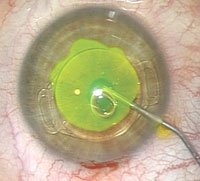Viscoelastic ‘sandwich technique’ lessens endothelial damage during enclavation
During phakic IOL implantation, the technique is a safe alternative to temporary sutures.
A new technique involving the implantation of an iris-fixated phakic IOL using two layers of viscoelastic could make enclavation safer, according to the developers of the technique.
The technique involves placing a high viscosity ophthalmic viscosurgical device (OVD) on the anterior surface of the iris-fixated IOL, the Artisan/ Verisyse lens (Advanced Medical Optics), and between two layers of medium viscosity OVD, according to Mana Tehrani, MD, and H. Burkhard Dick, MD.
The surgeons, who described this so-called “sandwiching” technique in a recent issue of the Journal of Refractive Surgery, consider it a safer alternative to temporary sutures. By maintaining a separation between the phakic IOL and the endothelium, the surgeon can minimize endothelial damage, the authors said.
An “advanced technique” is required to maintain a deep anterior chamber and to protect the endothelium during enclavation, they said.
“During many implantation procedures, flattening of the anterior chamber [occurs], in extreme cases even collapse of the AC,” Dr. Tehrani told Ocular Surgery News in an e-mail interview. “Consequently, touching the endothelium with instruments or the implants initiated the idea to create a technique that solves this problem.”
Technique
Patients should receive miotic drops and undergo general anesthesia for this procedure. Dr. Tehrani and Dr. Dick recommend performing two paracenteses at 10 and 2 o’clock and injecting Miochol-E (acetylcholine chloride, Novartis) into the anterior chamber in order to flatten the anterior side of the iris.
|
Image: Tehrani M, Dick HB |
Next, the first layer of ophthalmic viscoelastic device (OVD) should be injected through the paracenteses.
“Attention should be paid to placing the OVD first in the inferior peripheral chamber and then in the nasal and temporal peripheral regions to ensure aqueous fluid flow,” they said.
After inserting the initial OVD layer, the primary incision can be made. Placement, size and shape of the primary incision depend upon the IOL being used, according to the authors.
With the primary incision made, the surgeon next injects a cohesive, medium-viscous hyaluronic acid-based OVD to deepen the anterior chamber.
Drs. Tehrani and Dick said they prefer Healon (1% sodium hyaluronate, Advanced Medical Optics) and do not recommend using OVDs containing hydroxypropylmethylcellulose or chondroitin sulfate.
After the second layer of viscoelastic is inserted, the IOL is implanted in the anterior chamber and placed at the site of enclavation. After positioning the IOL, a high viscosity OVD, such as Healon5 (2.8% sodium hyaluronate, AMO), is layered on top of the IOL optic prior to enclavation.
“Thus, the high viscosity OVD is sandwiched on both sides by the medium viscosity OVD,” they said.
Healon5 is the “most effective in maintaining a deep anterior chamber, preventing anterior chamber collapse and minor OVD loss through the primary incision, and preventing endothelial touch by the phakic IOL,” the authors reported.
At the end of the procedure, all OVD material is removed by flushing and irrigating with balanced salt solution in front of the IOL.
Surgical tips
“In current iris-fixated lens implantation, a 5.2- to 5.5-mm-wide incision is necessary,” Dr. Tehrani and Dr. Dick said. “We present the sandwich technique combining a high-viscosity OVD with a viscoadaptive viscoelastic substance.”
To best maintain the anterior chamber, they said, a high-viscosity OVD is necessary and “the higher the zero shear viscosity, the better the maintenance.” Healon5 has both a higher zero shear viscosity and a longer relaxation time than Healon or Healon GV.
The authors caution that the OVD must be used properly to avert IOP spiking. The surgeon must be careful not to overfill the anterior chamber and not to inject the OVD into the angle. In addition, the Healon5 should be placed in one single injection directly onto the anterior surface of the IOL so the bolus can be removed easily.
“We believe our sandwich technique represents a good alternative to temporary sutures,” Dr. Tehrani and Dr. Dick said.
For more information:
- Mana Tehrani, MD, can be reached at Johannes-Gutenberg-University, Dept. of Ophthalmology, Langenbeckstr. 1, 55131 Mainz, Germany; +496131-173612; e-mail: tehrani@augen.klinik.uni-mainz.de.
Reference:
- Tehrani M and Dick HB. The “sandwich technique” for iris-fixated phakic intraocular lens implantation. J Refract Surg. 2006;22:96-98.
- Katrina Altersitz is an OSN Staff Writer who covers all aspects of ophthalmology.

